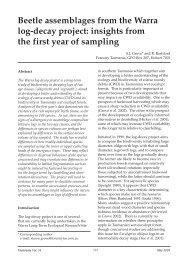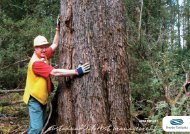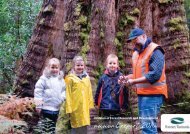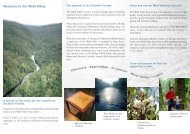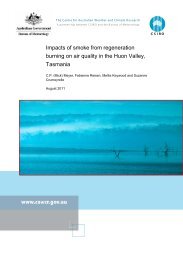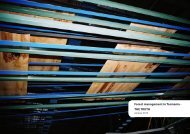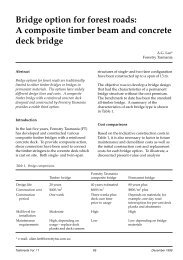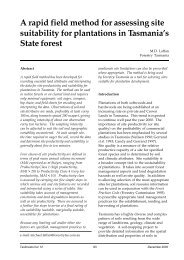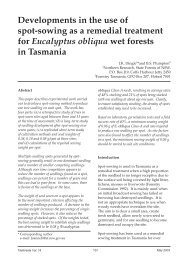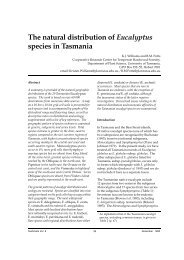Tasforests 13 - warra
Tasforests 13 - warra
Tasforests 13 - warra
Create successful ePaper yourself
Turn your PDF publications into a flip-book with our unique Google optimized e-Paper software.
Geology and soils of the Warra LTER<br />
Site: a preliminary description<br />
M.D. Laffan<br />
Forestry Tasmania<br />
Abstract<br />
The bedrock geology of the Warra LTER Site has<br />
been mapped at 1:25 000 scale. It is dominated<br />
by Jurassic dolerite and derived Quaternary<br />
slope deposits that together cover about twothirds<br />
of the area. Sedimentary and metamorphic<br />
rocks, comprising Precambrian quartzite,<br />
dolomite, slate and phyllite together with<br />
Permo-Carboniferous sedimentary rocks of<br />
the Parmeener Supergroup (mudstone, siltstone,<br />
sandstone, tillite, conglomerate) predominate<br />
in the west. Cambrian volcanic-ultramafic rocks<br />
and Quaternary alluvium and morainal deposits<br />
cover only minor areas.<br />
The soil pattern is diverse and shows strong<br />
links to geology and vegetation. Organic soils<br />
characterised by reddish-black fibrous peats are<br />
invariably associated with a vegetation cover<br />
of heath or scrub. These soils are predominant<br />
on quartzites, and they also occur sporadically<br />
on dolomite, slate, phyllite and dolerite. Where<br />
the vegetation cover is forest, mineral soils with<br />
gradational texture-profiles are prevalent. Texturecontrast<br />
profiles are mainly confined to soils<br />
formed on Permo-Carboniferous sandstones and<br />
conglomerates. Soils formed on Quaternary slope<br />
deposits derived from dolerite have been described<br />
and sampled in some detail from a limited area in<br />
the south-eastern part of Warra, but elsewhere<br />
only cursory descriptions are available and the<br />
distribution of the soils has not been mapped.<br />
Introduction<br />
The bedrock geology of the area has been<br />
mapped recently at 1:25 000 scale (Mineral<br />
e-mail: michael.laffan@forestrytas.com.au<br />
Resources Tasmania 1997, 2001) and at<br />
this scale provides reasonably reliable<br />
data on the spatial distribution and<br />
broad composition of geological units.<br />
Further information on the geology and<br />
geomorphology is given by Sharples (1994).<br />
Over most of the area, information on<br />
the properties and spatial distribution of<br />
soils is sparse. The soils have not yet been<br />
systematically mapped, and only generalised<br />
information on soil properties is available<br />
from previous land system surveys (Davies<br />
1988; Pemberton 1989). However, a relatively<br />
detailed soil study has been carried out<br />
recently on a small area of undulating and<br />
easy rolling land used for silvicultural trials<br />
in the south-eastern part of Warra.<br />
Pre-harvesting soil and site surveys together<br />
with intensive sampling for laboratory<br />
analysis were carried out during 1997–1998<br />
in four of the coupes (WR001B, WR008B,<br />
WR008C, WR008H) used for testing various<br />
harvesting techniques adjacent to Manuka<br />
road. Transects with sampling points<br />
established at intervals of either 25 m or<br />
50 m were established along access tracks<br />
cut within each coupe. A total of 150<br />
observations of substrate material, soil<br />
drainage class and understorey vegetation<br />
were completed for the four coupes. The<br />
soil observations were made using a hand<br />
auger to depths between 0.8–1.0 m, or<br />
shallower if impeded by rock. Soil samples<br />
were collected for determination of bulk<br />
density and selected chemical properties<br />
(pH, organic carbon, total nitrogen, total and<br />
available phosphorus, exchangeable calcium,<br />
magnesium, potassium and sodium). Soil<br />
drainage class was inferred from colour<br />
<strong>Tasforests</strong> Vol. <strong>13</strong> No. 1 23<br />
December 2001
patterns observed in soil samples obtained<br />
from auger borings at each site.<br />
Geology<br />
This section gives a brief overview of<br />
the main geological units described in<br />
the 1:25 000 scale map sheets (Nevada, Weld<br />
and Picton) covering Warra. The geological<br />
assemblage includes a wide range of<br />
sedimentary rocks (mudstone, siltstone,<br />
sandstone, tillite, conglomerate, dolomite,<br />
quartzite, coal), metamorphic rocks (slate<br />
and phyllite) and basic igneous rocks<br />
(basaltic volcanic rocks, ultramafic rocks,<br />
dolerite). They are outlined in chronological<br />
order from the oldest to the youngest.<br />
Precambrian rocks (c. > 580 million years)<br />
This group comprises three main rock types:<br />
(1) quartzite, (2) dolomite and (3) slate and<br />
phyllite. The quartzite occurs mainly in the<br />
western part of Warra on Gallagher Plateau,<br />
with a small inlier adjacent to Glovers Bluff<br />
in the east. At Glovers Bluff the quartzites<br />
are hard, white, fine-grained siliceous rocks.<br />
Dolomite, slate and phyllite occur mainly<br />
in the western part adjacent to the quartzites<br />
of Gallagher Plateau. The dolomite is<br />
generally fine-grained, pale-grey coloured<br />
and relatively pure apart from the presence<br />
of secondary silica.<br />
Cambrian rocks (c. 580–500 million years)<br />
This mainly volcanic-ultramafic association<br />
occupies only a very small area south-east<br />
of Glovers Bluff, where it comprises basaltic<br />
volcanic rocks, ultramafic igneous rocks,<br />
tuffs, and derived conglomerate, sandstone<br />
and shale.<br />
Permo-Carboniferous rocks (c. 300–250 million<br />
years)<br />
This group comprises sedimentary rocks<br />
of the Parmeener Supergroup and includes<br />
mudstone, siltstone, sandstone, tillite and<br />
conglomerate with lenses of coal in places.<br />
They occur in the western part of the region<br />
in association with older Precambrian rocks<br />
and in the north-east and south adjacent<br />
mainly to younger rocks of Jurassic age.<br />
Jurassic dolerite (c. 170 million years)<br />
Jurassic dolerite dominates the eastern part<br />
of Warra, covering about one-third of the<br />
total area. The dolerite is typically a very<br />
hard, dark bluish-grey crystalline rock,<br />
varying in grain size from very fine to<br />
medium. It weathers to form a distinctive<br />
yellow-brown or orange-coloured rind<br />
around exposed basement rocks and floaters.<br />
Quaternary deposits (c. < 1.8 million years)<br />
This unit includes alluvial deposits associated<br />
with the floodplains and terraces of the<br />
Huon and Weld Rivers and major tributary<br />
streams, as well as extensive deposits of<br />
colluvium on hill slopes, and minor<br />
morainal deposits (tills) at higher elevations.<br />
Colluvial deposits derived from Jurassic<br />
dolerite form a mantle of varying thickness<br />
over a relatively wide area in the central and<br />
south-eastern parts of Warra. They cover<br />
about one-third of the total area and extend<br />
from elevations of about 1200 m near Mount<br />
Weld in the north to about 80 m just to the<br />
west of the confluence of the Huon and Picton<br />
Rivers. These deposits comprise mainly<br />
cobbles and boulders derived from dolerite<br />
occurring within a clayey matrix, and overlie<br />
dolerite bedrock as well as other basements<br />
such as the Permo-Carboniferous rocks and<br />
Precambrian dolomite. Colluvium derived<br />
from other rock types also occurs, but its<br />
distribution and properties are poorly known.<br />
The colluvium is attributed to deposition<br />
caused by periglacial processes (mainly<br />
frost creep and solifluction) during the cold<br />
climatic phase of the last ice age, as well as<br />
more recent mass movement (landslides).<br />
The various Quaternary landforms typical<br />
of those occurring at Warra have been<br />
described by Sharples (1994).<br />
<strong>Tasforests</strong> Vol. <strong>13</strong> No. 1 24<br />
December 2001
Soils<br />
The soil pattern of the Warra LTER Site<br />
is highly diverse and reflects the marked<br />
variation in the environmental factors of<br />
geology, topography, vegetation and, to<br />
a lesser extent, climate. Geology plays a<br />
major role in determining soil characteristics<br />
and together they show clear links to the<br />
major types of natural vegetation occurring in<br />
the area. The soils are described in relation to<br />
the main geological units outlined previously.<br />
Because of their very limited distribution,<br />
soils on Cambrian rocks and Quaternary<br />
alluvium are not described here.<br />
Soils on Precambrian rocks and derived<br />
Quaternary slope deposits<br />
Organic soils formed under a vegetation<br />
cover of sedgeland/heath or scrub<br />
predominate on quartzite. Profiles are<br />
characterised by 20–50 cm of dark reddishbrown<br />
to reddish-black fibrous peat<br />
overlying sand and gravels. They have low<br />
levels of nutrients and are highly susceptible<br />
to erosion, particularly on exposed sites.<br />
On dolomite, slate and phyllite, the soils are<br />
highly variable, with organic soils similar<br />
to those formed on quartzite occurring<br />
under sedgeland/heathland or scrub and<br />
relatively deep mineral soils occurring<br />
under a forest cover. Wet eucalypt forest<br />
predominates with lesser areas of mixed<br />
forest and rainforest. The mineral soils<br />
generally have gradational texture-profiles<br />
characterised by dark-coloured loamy<br />
topsoils overlying brown clay loams and<br />
clays. Reddish-brown fibrous peat often<br />
occurs as a surface layer on soils in gullies<br />
and on protected slopes. Nutrient levels<br />
are likely to vary from low to medium.<br />
Soils on Permo-Carboniferous rocks and derived<br />
Quaternary slope deposits<br />
These soils occur mainly under forest,<br />
although sedgeland/heathland and scrub<br />
are locally dominant on a relatively small<br />
area in the western part of Warra. Profile<br />
features are determined largely by texture<br />
of the substrate; on sandstones the soils<br />
generally have texture-contrast profiles,<br />
whereas on siltstone or mudstone<br />
gradational texture-profiles predominate.<br />
Texture-contrast soils tend to be moderately<br />
well drained and have profiles characterised<br />
by dark-coloured sandy loams overlying<br />
bleached or pale-coloured sands or sandy<br />
loams that in turn overlie yellowish-brown<br />
sandy clay loams. Nutrient levels are likely<br />
to be low, and erodibility is assessed as high.<br />
Gradational soils formed on siltstones and<br />
mudstones generally have somewhat<br />
impeded drainage, and profiles are<br />
characterised by loamy topsoils overlying<br />
grey and brown-mottled clay loams and<br />
clays. Nutrient levels are likely to be higher<br />
and erodibility lower than texture-contrast<br />
soils on sandstone.<br />
Soils on Jurassic dolerite and Quaternary<br />
deposits derived from dolerite<br />
Soils formed on dolerite bedrock and<br />
derived colluvium cover the largest area<br />
within Warra. They can be subdivided<br />
into two main components: (1) soils at high<br />
elevation under alpine vegetation (heath,<br />
herbfields, scrub) and (2) soils at mid and<br />
low elevation under wet forest.<br />
Soils under alpine vegetation.—These soils<br />
are generally shallow and extremely stony,<br />
and they often occur in association with bare<br />
rock fields and scree slopes. Surface layers<br />
frequently comprise organic loams or fibrous<br />
peats overlying shallow brown or greycoloured<br />
loamy subsoils with abundant rock<br />
fragments. Deeper soils formed on glacial<br />
till sometimes occur on lower slopes under<br />
open woodland. They have gradational<br />
profiles characterised by very rocky, loamy<br />
topsoils overlying yellowish-brown clayey<br />
subsoils with abundant rock fragments.<br />
Nutrient levels are likely to be low.<br />
Soils under wet forest.—These soils exhibit<br />
a very wide range of stoniness and depth to<br />
bedrock. Relatively deep (> 1 m) soils often<br />
occur on slope deposits, particularly those at<br />
<strong>Tasforests</strong> Vol. <strong>13</strong> No. 1 25<br />
December 2001
Table 1. Results of bulk density and some chemical properties for surface and subsurface layers from soils on<br />
Quaternary slope deposits derived from dolerite, Manuka Road. (Data are means ± standard deviations.)<br />
Soil Depth (cm)<br />
Soil Property 0–5 cm 5–10 cm 0–10 cm 10–20 cm<br />
Bulk density (Mg/m 3 ) 0.58 ± 0.<strong>13</strong> 1 0.84 ± 0.22 1 0.74 ± 0.14 -<br />
pH 4.8 ± 0.4 5.0 ± 0.4 - 5.1 ± 0.4<br />
Organic C (%) 7.7 ± 2.3 4.0 ± 0.9 - 2.6 ± 0.7<br />
Total N (%) 0.28 ± 0.08 0.18 ± 0.05 - 0.12 ± 0.04<br />
Total P (%) 0.015 ± 0.006 0.012 ± 0.005 - 0.01 ± 0.005<br />
Available P (mg P/kg) 2 4.6 ± 3.0 2.0 ± 1.2 - 0.6 ± 0.8<br />
1 Results of 10 samples from one coupe<br />
2 Colwell extraction method<br />
lower elevation derived from periglacial<br />
weathering and accumulation. Conversely,<br />
shallow and very stony soils frequently<br />
occur on ridge crests and very steep slopes<br />
in association with exposed bedrock. Soil<br />
drainage is also highly variable, ranging from<br />
rapidly drained, extremely stony soils to<br />
poorly drained soils in depressions and lower<br />
slopes subject to prolonged seepage from<br />
sites upslope. Generally, however, most<br />
soils are well drained or imperfectly drained<br />
with gradational texture-profiles. These<br />
soils are described in the following section.<br />
Soils of the silvicultural trial sites, Manuka Road<br />
Results from transects carried out in each of<br />
the four compartments show that all the soils<br />
are formed on slope deposits derived from<br />
Jurassic dolerite. Stones and large boulders<br />
of dolerite frequently occur on the soil<br />
surface. Permian sedimentary rocks underlie<br />
the slope deposits at variable depths but<br />
are generally greater than 1.5 m deep.<br />
Immediately to the east of the trial sites,<br />
Permian rocks outcrop on the soil surface and<br />
to the west they are exposed in road batters.<br />
Analysis of the results for drainage<br />
class reveals that the majority (56%) of<br />
the soils in the trial sites are well drained or<br />
moderately well drained, with subdominant<br />
(32%) imperfectly drained soils and relatively<br />
minor (12%) poorly drained soils. Clear<br />
links between soil drainage class and<br />
understorey vegetation were recorded<br />
during the transects. Well-drained soils<br />
often had a cover of Banksia (Banksia<br />
marginata), whereas imperfectly drained<br />
soils frequently had a dense cover of cutting<br />
grass (Gahnia grandis) and poorly drained<br />
soils invariably supported tea-trees<br />
(Leptospermum spp.) and paper-barks<br />
(Melaleuca spp.). The poorly drained soils<br />
occur mainly in shallow depressions or<br />
small hollows formed on gently undulating<br />
slopes, whereas freely drained soils occur<br />
preferentially on rises and mounds in<br />
undulating terrain, and on rolling and<br />
steeper slopes at higher elevation.<br />
Well-drained and moderately well-drained<br />
soils are characterised by relatively thin<br />
(< 10 cm) dark brown, clay loam topsoils<br />
overlying yellowish-brown light to<br />
medium clays. They are most closely<br />
correlated with ‘Kermandie’ soil profile<br />
class (Grant et al. 1995). Imperfectly drained<br />
soils are characterised by relatively thin<br />
(< 10 cm), very dark greyish-brown, humic<br />
clay loam topsoils overlying yellowishbrown,<br />
light and medium clays with many<br />
light grey mottles and few to common dark<br />
brown worm casts. They are most closely<br />
correlated with ‘Murdunna’ soil profile<br />
class (Grant et al. 1995). Full descriptions<br />
of a representative profile of both welldrained<br />
and imperfectly drained soils<br />
are appended.<br />
Analytical data for surface (0–5 cm, 5–10 cm)<br />
and subsurface (10–20 cm, 20–30 cm) layers<br />
<strong>Tasforests</strong> Vol. <strong>13</strong> No. 1 26<br />
December 2001
are presented in Pennington and Laffan<br />
(2001). Statistical analyses comparing welldrained<br />
and imperfectly/poorly drained<br />
soils showed that significant differences<br />
occur in only two properties; well-drained<br />
soils have higher total phosphorus (0–5 cm),<br />
and lower exchangeable magnesium (0–5 cm<br />
and 5–10 cm) than imperfectly drained soils.<br />
Overall results showing means from<br />
40 surface soil samples from the four coupes<br />
are given in Table 1. They show that surface<br />
layers are typically very strongly acid<br />
(pH < 5.0), and have relatively high levels<br />
of total N (> 0.2%) and organic C (> 5.0%),<br />
medium levels of total P (0.010–0.025%) and<br />
low available P (< 10 mg P/kg). The values<br />
for organic C, total N and P, and available P<br />
are generally slightly lower than those<br />
analysed for the Kermandie and Murdunna<br />
soil profile classes (Grant et al. 1995).<br />
Erodibility varies from low in welldrained<br />
soils to moderate in imperfectly<br />
drained soils.<br />
Conclusions<br />
Although the bedrock geology of the area<br />
has been mapped at a scale of 1:25 000,<br />
information on the surficial geology is much<br />
less reliable. Apart from a limited area of<br />
soils formed on Quaternary slope deposits<br />
derived from dolerite in the south-eastern<br />
part, only cursory soils information is<br />
available for Warra. Further field studies<br />
are required to fully characterise the major<br />
soils and show their distribution.<br />
References<br />
Davies, J.B. (1988). Land Systems of Tasmania, Region 6: South, East and Midlands. Department of<br />
Agriculture, Tasmania.<br />
Grant, J.C., Laffan, M.D., Hill, R.B. and Neilsen, W.A. (1995). Forest Soils of Tasmania. A Handbook for<br />
Identification and Management. Forestry Tasmania, Hobart.<br />
Mineral Resources Tasmania (1997). Digital Geological Atlas 1:25 000 series. Weld, Sheet 4623.<br />
Mineral Resources Tasmania (2001). Digital Geological Atlas 1:25 000 series. Picton, Sheet 4622.<br />
Pemberton, M. (1989). Land Systems of Tasmania, Region 7: South West. Department of Agriculture,<br />
Tasmania.<br />
Pennington, P. and Laffan, M. (2001). Procedures for the measurement of changes in soil physical<br />
properties following logging of wet Eucalyptus obliqua forest. Final Report of project 99.804, Forest<br />
and Wood Products Research and Development Corporation.<br />
Sharples, C. (1994). Landforms and geological sites of geoconservation significance in the Huon Forest<br />
District. Vol. 2: Description. A report to the Forestry Commission, Tasmania.<br />
<strong>Tasforests</strong> Vol. <strong>13</strong> No. 1 27<br />
December 2001
Appendix 1. Profile descriptions for typical well-drained and imperfectly drained soils in<br />
Warra silvicultural trial sites.<br />
WELL-DRAINED SOIL<br />
Correlation: Most closely related soil profile class is ‘Kermandie’ (Grant et al. 1995).<br />
Location: Warra 001B, near centre of coupe.<br />
Landform: Undulating lower slopes of hill/mountain.<br />
Vegetation: Wet eucalypt forest dominated by E. obliqua.<br />
Parent material: Quaternary slope deposits derived from Jurassic dolerite.<br />
Profile description<br />
A1 0–3 cm<br />
Dark brown (7.5YR 3/4) clay loam; very weak strength; moderately<br />
developed 2–5 mm subangular blocky structure; < 10% subangular<br />
gravels (50–100 mm); many fine and medium roots.<br />
B21 3–55 cm<br />
Yellowish brown (10YR 5/8) light to medium clay; weak strength;<br />
moderately developed 10–20 mm subangular blocky breaking to<br />
5–10 mm subangular blocky structure; 20–30% subangular boulders<br />
(300–600 mm); few worm casts; few red (2.5YR 4/8) 5–10 mm<br />
mottles; common fine and medium roots.<br />
B22 55–90+ cm Yellowish brown (10YR 5/6) medium clay; few red (2.5YR 4/8)<br />
5–10 mm mottles; weak strength; strongly developed 5–10 mm<br />
subangular blocky breaking to 2–5 mm subangular blocky structure;<br />
20–30% subangular boulders (300–600 mm); common fine and<br />
medium roots.<br />
Notes: Red mottles in B21 and B22 are probably very strongly, red-weathered<br />
dolerite fragments or they may result from previous hot fires in the root<br />
zone. Characteristic features: gradational texture profile with thin clay<br />
loam A1 horizon overlying uniformly coloured bright yellow-brown<br />
clayey subsoils often with red mottling.<br />
<strong>Tasforests</strong> Vol. <strong>13</strong> No. 1 28<br />
December 2001
Appendix 1. Continued.<br />
IMPERFECTLY DRAINED SOIL<br />
Correlation: Most closely related soil profile class is ‘Murdunna’ (Grant et al. 1995).<br />
Location: Warra 001B, about 50 m north of well-drained profile.<br />
Landform: Undulating lower slope of hill/mountain.<br />
Vegetation: Wet eucalypt forest dominated by E. obliqua.<br />
Parent material: Quaternary slope deposits derived from Jurassic dolerite.<br />
Profile description<br />
A1 0–7 cm Very dark greyish brown (10YR 3/2) humic clay loam; few dark grey (10YR 4/1)<br />
2–5 mm mottles; very weak strength; moderately developed 5–10 mm<br />
subangular blocky structure; 5–10% 40–50 mm subangular coarse fragments;<br />
many fine and medium roots.<br />
B21 7–30 cm<br />
Yellowish brown (10YR 5/4) light clay; few grey (10YR 5/1) and strong brown<br />
(7.5YR 5/6) 2–5 mm mottles; weak strength; moderately developed 10–20 mm<br />
angular blocky structure; 10–15% subangular 100–150 mm dolerite fragments;<br />
common dark brown (10YR 4/3) worm casts; many fine and medium roots.<br />
B22 30–58 cm Yellowish brown (10YR 5/4) light to medium clay; many light grey (10YR 6/1)<br />
and yellowish red (5YR 5/6) 2–5 mm mottles; weak strength; moderately<br />
developed 10–20 mm angular blocky structure; few dark brown (10YR 4/3)<br />
worm casts; many fine and medium roots.<br />
B23 55–90+ cm<br />
Yellowish brown (10YR 5/6) medium clay; many greenish grey (5GY 6/1) and<br />
yellowish red (5YR 5/6) 2–5 mm mottles; weak strength; moderately developed<br />
5–10 mm angular blocky structure; many fine and medium roots.<br />
Characteristic features: gradational texture profile with humic clay loam A1 horizon overlying<br />
grey and orange mottled clayey subsoil.<br />
<strong>Tasforests</strong><br />
<strong>Tasforests</strong> Vol. <strong>13</strong> No. 1 29<br />
December 2001




